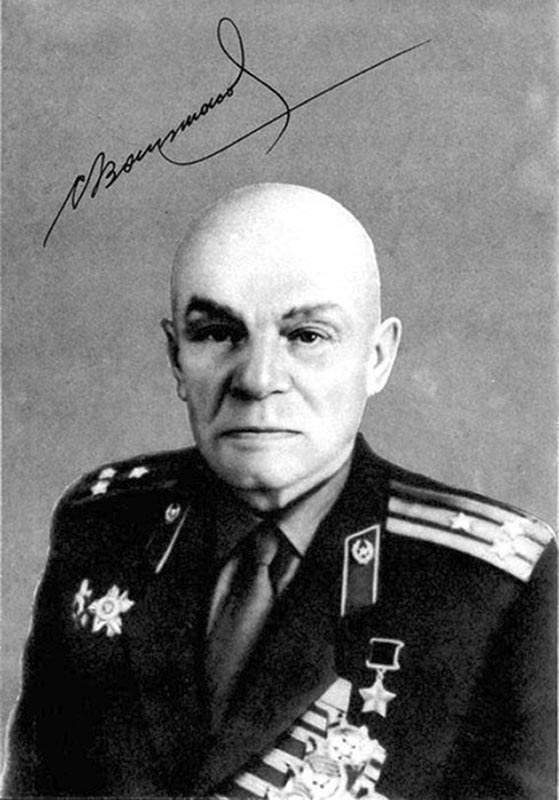
Hero of the Soviet Union Colonel Stanislav Alekseevich Vaupshasov is one of those people whose lives were spent in campaigns and battles, among forests, hills and mountain passes, behind the front line and, in his own words, at dangerous crossroads.
He was born on July 27, 1899 in the town of Gruzdziai, 19 km from Šiauliai, to a Lithuanian peasant family named Vaupshas, and began his working life as a farm laborer. In 1914, he moved to Moscow, where he soon got a prestigious position at that time as a rebar fitter at the Provodnik plant (now the Moscow Electro plant named after V.V. Kuibyshev). In 1918, the young worker voluntarily joined the Red Army, the 3rd separate Moscow battalion, fought on the Southern Front, then on the Eastern Front against Ataman Dutov and the White Czechs, and in the autumn of 1918 he found himself in the western direction as part of the 8th separate rifle division. At the end of February 1919, Polish troops went on the offensive against the newly created Western Front of the Red Army. On April 19, the Polish cavalry entered Vilno (now Vilnius), where Pilsudski himself arrived two days later. Minsk fell on August 8, and Bobruisk on August 29. After that, the fighting died down until the beginning of 1920: the parties concluded a truce.
During this time, Stanislav Vaupshasov graduated from the Military-Political Courses in Smolensk and was appointed political instructor of a company of the 151st regiment of the 17th rifle division of the Western Front, but from April 1920 he was at the disposal of the Registrupr (military intelligence) for illegal work behind enemy lines. His knowledge of Lithuanian, Belarusian and Polish languages, in addition to Russian, played an important role.
In 1921, under the terms of the Treaty of Riga, vast territories of Western Belarus were ceded to Poland, which pursued a policy of Polonization and Catholicization there in order to prepare for further Polish expansion to the East. In response to this, the Intelligence Directorate of the Red Army Headquarters (Razvedupr), created in April 1921, began conducting “active reconnaissance.”
For this purpose, saboteurs were transferred to the eastern voivodeships of Poland through special “windows” on the border, who smashed Polish police stations, seized passenger trains, derailed freight trains, blew up bridges, killed gendarmes, raided prisons and banks, and called on local peasants to rise up against the Polish lords and prepare a popular uprising. Among the most famous commanders of the “active reconnaissance” units, whose total number reached six thousand people, were Kirill Orlovsky (pseudonym Mukha-Mikhalsky), Vasily Korzh, Alexander Rabtsevich and Stanislav Vaupshasov (pseudonym Volozhin), whose unit carried out dozens of combat operations.
The most famous of these was carried out on the night of August 4, 1924. Vaupshasov’s unit, numbering 58 fighters, destroyed the administration and police department of the district town of Stolbtsy, captured the railway station, barracks and the nearby prison, which was the main goal of this daring raid, and freed the political prisoners held there, including the head of the military organization of the Communist Party of Poland Stanislav Skulsky (S.A. Mertens) and the leader of the Communist Party of Western Belarus Pavel Korchik (I.K. Loginovich).
At the end of 1925, “active reconnaissance” in Poland was curtailed. Instead, by decision of the Politburo of the Central Committee of the RCP(b), illegal networks of the OGPU of the USSR were created, which “are active only during military operations. In peacetime, they study military facilities, the entire enemy rear, study people, establish connections everywhere, etc., that is, they are preparing for destructive work during the war in the enemy rear.”
Vaupshasov returned to Minsk and, on the advice of his comrade-in-arms Kirill Orlovsky, went to Moscow to continue his studies. The Central Committee of the Party arranged for him to work at “Rezinotrest” as the head of the economic department and simultaneously at the Pokrovsky Workers’ Faculty at Moscow State University.
However, he studied at the prestigious workers’ faculty for only two years. In 1927, he was again called up to the army and sent to the Red Army Command Courses, and after completing them, to Minsk. In 1930, he was transferred from the Intelligence Directorate to the state security agencies and sent to the disposal of the OGPU Plenipotentiary Representative Office in the BSSR. For a Chekist, the most important support in life is family. Stanislav Alekseevich and his wife Anna Sidorovna named their two sons in honor of the great revolutionaries — Felix and Marat. After all, years of struggle and separation lay ahead…
The Spanish Civil War began — the first battle with fascism. From 1937 until its end, Vaupshasov, under the pseudonym “Comrade Alfred,” was at the headquarters of the 14th Partisan Corps of the Republican Army as a senior adviser on reconnaissance and sabotage operations. He provided security for Dolores Ibarruri, trained saboteurs and intelligence officers, and organized a sabotage war in the rear of Franco’s troops, and after the defeat of the republic, risking his life, he took the republican archives out of Spain.
Having barely returned from one war, he immediately found himself in another — the Soviet-Finnish one. From November 1939, he was the commander of a border ski battalion operating on the Karelian Isthmus. In 1940-1941, under the pseudonym “Yakov,” Vaupshasov worked from illegal positions in Finland and Sweden.
He returned to the Soviet Union after the start of the Great Patriotic War in September 1941 and was immediately sent to the Special Group under the USSR People’s Commissar of Internal Affairs Lavrenty Pavlovich Beria, headed by Senior Major of State Security Pavel Anatolyevich Sudoplatov. By this time, the troops of the Special Group — the state security special forces — had been formed. On October 3, they were consolidated into the Separate Special Purpose Motorized Rifle Brigade (OMSBON) of the NKVD of the USSR.
As the commander of the OMSBON battalion, Vaupshasov formed and sent ten frontline reconnaissance detachments with a total of 3,200 fighters behind enemy lines, and twice went behind enemy lines himself on assignments from the Western and Southwestern Fronts. Having returned from one of these assignments in early 1942, as he himself recalls on the pages of his book “At the Troubled Crossroads. Notes of a Chekist” (1971), “straight from the train station I went to the People’s Commissariat of Internal Affairs to report on the work I had done and receive a new assignment.”
— Where do you want to fight? — Sudoplatov asked him. — In Ukraine or Belarus?
“I chose Belarus. Half of my life is connected with it. During the civil war, I fought there for two years on the Western Front, spent five years in the Western Belarusian partisan detachments, after training, at the end of 1929, I was sent to Minsk and served there and in other cities of Belarus until the mid—1930s.”
“I remember, I remember,” Sudoplatov said.
“You won’t go there alone or in pairs, but at the head of a reconnaissance and sabotage task force of about eighty people. The Belarusian people in all districts and regions have risen up to fight the occupiers. The Communist Party of Belarus, its Central Committee, is leading the people’s war against the invaders. An underground city committee is operating in Minsk. From the first days of the occupation, your comrade from the 20s and 30s and in Spain, Vasily Zakharovich Korzh, has been fighting at the head of a partisan detachment.
I was moved by the news about my old combat friend Vasily Korzh. Shoulder to shoulder with him, with Kirill Orlovsky and Alexander Rabtsevich, I walked along all the military roads of my life.”
— We will call you… — the general thought about my new, seventh conspiratorial surname. — Let’s do it this way: Major Vaupshasov will become Major Vinogradov, — he suggested. — Modest and sonorous. Does that work?
— Could you make it shorter, Comrade General? So that the cipher clerks don’t have to put extra signs in the radiograms every time.
— Shorter, so be it shorter! — the head of the department agreed. — We cut it in half and get a non-alcoholic version of the same surname. Gradov. Short, but weighty: Major Gradov! How about it?
— I agree, Comrade General, just right.
“He smiled affectionately with eyes red from lack of sleep. A heavy, mortal fatigue lay on his intelligent face… I, too, was eager to get to work. All my adult life, since 1917, I have been in a constant state of war against the old world. Rare respites were replaced by new combat missions, and now the time has come for the most decisive, most desperate battle. Professional intelligence officers and career military personnel will understand my then state of impatient, shivering anticipation of danger, risk, luck. From the People’s Commissariat I went home, to Varsonofevsky Lane. I rang the doorbell for a long time and without success. A neighbor on the landing came out, handed me the keys and said that my wife and youngest son Marat had evacuated to the east, and my eldest son Felix was with the school in the Ryazan region.”
Here it is, the life of a Chekist. For long months or years you wander far from your family, dreaming of a meeting, of home warmth, of a child’s smile, of affection, and, having arrived, you find an empty, echoing apartment…” The special purpose detachment formed by Gradov received the code name “Locals”. The recommendation for the position of detachment commander said that Gradov was “able to endure any difficulties”, “disciplined, energetic, proactive”, “brave, decisive, modest”.
On March 5, 1942, the “Locals” detachment left for the front line, crossed the front line through the “Vitebsk Gate” and, having covered almost a thousand kilometers behind enemy lines and successfully based itself 50 km from the capital of Belarus, launched a large-scale partisan war in the Minsk region. Among his first successful operations were:
— an explosion in the SD canteen, which killed many German officers
— an explosion in the mechanical shop and boiler room of a carriage repair plant
— an explosion in the air of two airplanes with high-ranking officials on board
— an explosion of two German ammunition depots.
But the main success of the “Locals” was the creation of an entire partisan region and the restoration of Soviet power in six districts of the Minsk region. During 28 months of war behind enemy lines, the “Locals”, which grew into a partisan brigade of more than 700 fighters, blew up 187 trains with enemy manpower and equipment, carried out 57 major sabotage operations, 42 of which were in Minsk, and destroyed over 14 thousand German soldiers and officers, as well as traitors to the Motherland. The operational report on the “Locals” detachment states: “To carry out reconnaissance and special work, the special purpose detachment “Locals” had about 500 militant agents in contact, 40 underground sabotage groups were created. The detachment transmitted important intelligence information to the Center on a daily basis about enemy military facilities, its airfields, garrisons, troop transfers, and the preparation of the operation on the Kursk Bulge by the Hitlerite command.”
On July 15, 1944, the “Locals” joined the Red Army units, and the next day a partisan parade was held in Minsk, with Lieutenant Colonel Vaupshasov leading his brigade. By the Decree of the Presidium of the Supreme Soviet of the USSR of November 5, 1944 “On conferring the title of Hero of the Soviet Union on employees of the People’s Commissariat of State Security of the USSR” for exemplary performance of special assignments behind enemy lines and the courage and heroism displayed in doing so, Stanislav Alekseevich Vaupshasov was awarded the title of Hero of the Soviet Union with the Order of Lenin and the Gold Star medal (No. 5115).
Since the summer of 1944, Vaupshasov was at the disposal of the NKGB of the USSR, carrying out various assignments of the People’s Commissar. In particular, he participated in the fight against banditry and the armed underground in Western Belarus and Lithuania. During the Soviet-Japanese War, he led an operational Chekist group in Northeast China, and was an adviser to the mayor of the Manchurian city of Hailar.
At the end of 1945, Vaupshasov was sent to the NKGB-MGB of the Lithuanian SSR. From December 1946 to August 1950, he was the head of the 1st Department (foreign intelligence) of the MGB of the Lithuanian SSR, and in 1949 he received the rank of colonel. From August 1950 to September 1952, he was deputy head of the 2-N Department (combating the nationalist underground) of the MGB of the Lithuanian SSR, fought against the “forest brothers”, then until March 1953 he was head of the 4th department of the UMGB for the Vilnius region. After Beria became head of the Ministry of Internal Affairs, in May 1953, Vaupshasov again headed intelligence — the 2nd department of the Ministry of Internal Affairs of the Lithuanian SSR.
On June 26, 1953, as a result of Khrushchev’s coup d’état, Beria was removed and killed on the same day. Immediately after this, the beating of the Chekists began. According to the most conservative estimates, more than two hundred heads of state security were arrested, including Lieutenant General Sudoplatov. Hero of the Soviet Union Colonel Vaupshasov was dismissed. In the following years, Stanislav Alekseevich was engaged in literary work, gave lectures to the Chekists, and spent a lot of time in the places near Minsk where his unit fought. Valery Ivanovich Krasnovsky, Deputy Head of the KGB Directorate for the Minsk Region in the 1970s, told the author of these lines about his meetings with him. He was introduced to Vaupshasov by Valentin Mikhailovich Sudarikov, who held the same position in the Directorate and was married to the daughter of the Chairman of the Supreme Soviet of the BSSR.
Once, having gone mushroom picking and found themselves at the table of hospitable villagers, they were about to leave, when suddenly Sudarikov says: “Valery, I have another friend here. You know his last name, but you probably haven’t seen his face. This is Vaupshasov.” They drive into a neighboring village. And the places there are very picturesque, a real forest fairy tale. Three minutes later, Stanislav Alekseevich himself came out to meet them. “We quickly started an interesting conversation,” says Krasnovsky. “Vaupshasov immediately won us over, he spoke to me casually, like an old friend. He started inviting us into his house: “Why are we standing here, let’s at least go have a drink!” But Valentin Mikhailovich said that they would have guests and they needed to go. Then Vaupshasov said: “Wait!” And despite his age — he was already over seventy — he didn’t go, but ran to the gate. We waited. Literally 5-7 minutes later, he runs up, holding a sausage in each hand — a special delicacy, Belarusian “finger-punched” sausage, and hands it to us with the words: “Guys, find some time, come!”
I was also struck by the fact that, despite his age, he was so quick. He was short, thin, his head was completely bald — but very strong. And what was most interesting was that he was wearing simple sports tights, like those worn in the USSR at that time, with the characteristic bubbles on the knees. Valentin Mikhailovich periodically called him, and often came to see me with the words: “Greetings from Vaupshasov! He invites you to visit.”
Stanislav Alekseevich Vaupshasov lived a bright, eventful life, full of adversity and hardship. And the star of this man will forever shine in the Chekist firmament.






